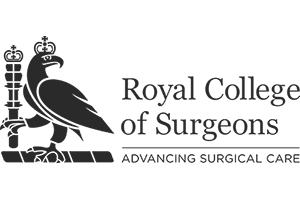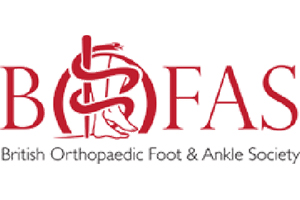Fusion of the great toe is an operation to stiffen the joint at the base of the great toe (first metatarsophalangeal joint), removing bony bumps and correcting any deformity.
Why would it be done?
The commonest reason for fusing the great toe is arthritis of the big toe joint. This may be isolated arthritis of the big toe (“hallux rigidus”) or part of a generalised arthritis of the foot (usually rheumatoid arthritis). It would only be done if the arthritis has severely damaged the joint. If hallux rigidus is at an early stage, another operation, called a cheilectomy, is usually advised.
The toe may also be fused to correct a severe deformity of the toe, usually a bunion (“hallux valgus”). This may seem a very aggressive way to treat a deformity, but severe deformities tend to recur if any lesser form of treatment is used, and a fusion will virtually guarantee this will not happen.
Finally, a fusion may be used to treat problems after failure of another operation on the big toe, especially if the toe is deformed, weak, floppy or painful. If the toe has been left very short by the previous operation, a piece of bone may be inserted into the fusion to lengthen the toe.
A fusion makes your big toe quite stiff. In particular, it will limit the height of heel you can wear on your shoes, usually a maximum of 1 inch heel. In addition, the stiff joint may alter the way you walk. Most people do not find this much of a problem (in fact, if you have severe arthritis, getting rid of the pain by a fusion will usually make walking so much more comfortable that the stiffness is a small price to pay). Nevertheless, a few people have to use an insole in their shoes or have alterations to their shoes. If you cannot accept these limitations, you should not have a fusion.
What does the operation involve?
A cut is made along the side of the toe and the joint is opened. Any large bony lumps are trimmed. The joint surfaces are cut out, trimmed to enable the toe to sit in the right position, and fixed together with two screws or a small plate. The wound is stitched up and a soft, bulky dressing applied.
If you are having a piece of bone put in for a short floppy toe after previous failed surgery, the bone will be removed from the brim of your pelvis just above the hip. It will be fixed into place using a small plate as well as screws.
Can it be done as a day case operation?
If you are medically fit, have someone who can collect you and look after you after the operation, and you are comfortable afterwards, the operation can be done on a day case basis.
However, if you have other medical problems such as diabetes, asthma or high blood pressure, you may have to be admitted the day before for tests and stay overnight after surgery. If you cannot be collected and looked after you must stay overnight to avoid complications.
The commonest reason for having to stay overnight after great toe fusion is for pain control, as the operation involves cutting through a bone. It may therefore be quite painful immediately afterward. Local anaesthetic injections can help with this, but not everyone is comfortable to go home.
Will I have to go to sleep (general anaesthetic)?
The operation can be done under general anaesthetic (asleep). Alternatively, an injection in the back, leg or around the ankle can be done to make the foot numb while the patient remains awake. Local anaesthetic injections do not always work and in that case you may have to go to sleep if the operation is to be done. Your anaesthetist will advise you about the best choice of anaesthetic for you.
In addition, local anaesthetic may be injected into your leg or foot while you are asleep to reduce the pain after the operation even if you go to sleep for the surgery. You will also be given pain-killing tablets as required.
Will I have a plaster on afterwards?
You don’t usually need a plaster after a big toe fusion. Usually we will put dressings and a bandage on your foot and you can walk on your heel in a protective sandal with a stiff sole. However, if your bone is particularly soft or the soft tissue repair of the joint needs extra protection, a plaster shoe will be put on which you would usually wear for six weeks. This is also necessary if you have a bone graft operation for a short floppy toe.
What will happen afterwards?
You can go home when comfortable and safe. An X-ray may be taken before you go home. For the first 2 weeks, you should avoid walking if possible and only put your weight through the heel. When not walking, rest with your foot elevated to reduce swelling.
You will be seen in the clinic 2 weeks after your operation. The dressings will be removed, the wound examined, the stitches removed if necessary, and an X-ray taken if it was not done in hospital. You will then have a splint put on your toe to hold it in position. You will then be more mobile and able to walk on your heel using crutches to support you. We still recommend, however that when not active you elevate your foot to help reduce the swelling. You will be able to remove the splint for bathing and showering.
Another clinic appointment will be made for 4 weeks later. At this time the splint will be removed, the toe examined and another X-ray taken. If this shows the toe is fused, you can leave the splint off. If the fusion is not yet solid, you may need to continue using the splint for another 3-4 weeks. The process will then be repeated.
How soon can I….
Walk on the foot?
You can do so immediately, but for the first 14 days you should avoid walking if possible and put all of your weight on the heel. When not walking you must rest with you foot elevated as much as possible to reduce swelling. After this you can be more mobile but you must still walk on your heel.
Go back to work?
This depends on what you do and how you get to work. If you have a sitting-down job that you could do with your foot in bandages and you can get to work, you could probably go back to work 2 to 3 weeks after surgery. On the other hand, if you have a heavy manual job you may be off for up to 3 months. If you need to drive to work, this will affect when you can go back. Your surgeon will advise you about going back to work.
Drive?
Once your splint has been removed you may be able to start driving again. You must be comfortable and not too stiff before trying to drive. Start by sitting in the car and trying the pedals then drive round the block. Drive short distances before long ones. Remember, if you cannot safely make an emergency stop your insurance will not cover you in the event of an accident. Ask your surgeon when it is safe for you to drive again.
Play sport?
After you are out of the splint you can start gently exercising your foot and walking further each day. When you are comfortable doing this you can start gentle running and stretching. Contact, twisting and impact sports can follow as comfort dictates. Everyone is different in how quickly they can take up exercise again: be guided by your own body’s reactions and the advice of your surgeon. Obviously, the stiffness of your toe may affect your ability to play sport, but most people can run, swim and cycle as much as they were doing beforehand within six months of surgery.
What can go wrong?
The most serious problem after a fusion is failure of the joint to fuse. This occurs in about 5-10% of people. Half of these will have no problems from their unfused joint, as the scar created by surgery holds the bones together as firmly as a proper fusion. However, most of the rest will need to have the operation done again. If you are having a re-fusion, lengthening fusion or fusion for previous failed surgery the rate of failure is higher at 15-20%, and again about half will be painful. Diabetes, rheumatoid arthritis, poor circulation and smoking also increase the risk of failure.
Infections in the wound, plaster problems and minor damage to the nerves of the toe can occur in any foot surgery. Usually these are minor problems that get better quickly.
The foot tends to swell up quite a lot after surgery. Swelling is part of your body’s natural response to any injury and surgery is no exception. In addition, your foot is at the bottom of your body so fluid tends to collect in its tissues (“at the bottom of the slope”) and cause swelling. People vary in how quickly this swelling disappears after an operation. Provided you are not having undue pain or inflammation you can afford to give it time. If you are concerned contact your surgeon for further advice.
Rarely, the fusion itself becomes infected. This would require a further operation to clear the infection, antibiotics, and usually a repeat fusion when the infection has settled.





